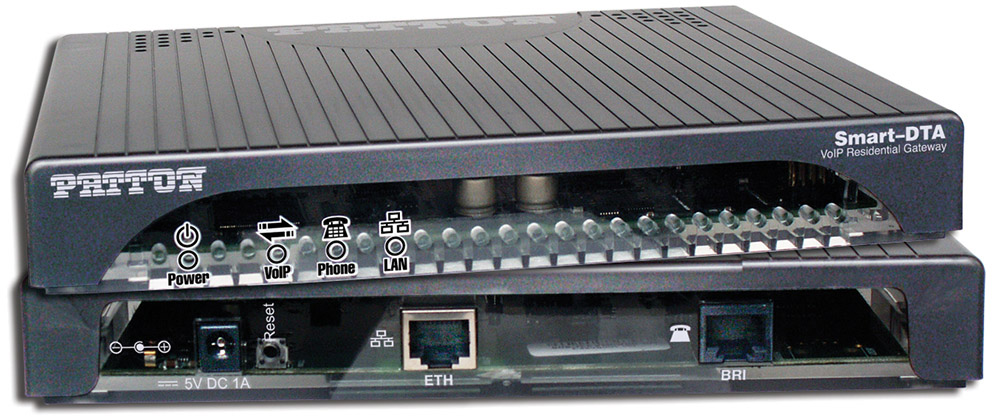Patton
SN-DTA/2BIS2V
SmartNode ISDN BRI VoIP Terminal Adapter
The SmartNode Digital Terminal Adapter (DTA) brings the advantages of high-quality VoIP to ISDN users. It connects ISDN terminals on 2 BRI/So ports, and converts 2 concurrent voice or fax calls to SIP or H.323.





Patton
SN-DTA/2BIS2V
SmartNode ISDN BRI VoIP Terminal Adapter
The SmartNode Digital Terminal Adapter (DTA) brings the advantages of high-quality VoIP to ISDN users. It connects ISDN terminals on 2 BRI/So ports, and converts 2 concurrent voice or fax calls to SIP or H.323.
Resources
Description
The SmartNode Digital Terminal Adapter (DTA) brings the advantages of high-quality VoIP to ISDN users. It connects ISDN terminals on 2 BRI/So ports, and converts 2 concurrent voice or fax calls to SIP or H.323.
The SmartNode DTA enables integration of ISDN network users into a local VoIP phone service, or extends an ISDN line of a PBX to a remote site over IP. It offers a simple end-user configuration interface and connects both to a PBX in point-to-point mode and an So bus in point-multipoint mode.The SN-DTA enables the connection of ISDN terminals or SOHO PBXs to a VoIP network or Internet Telephony Service. It can connect to ISDN PBXs in point-to-point mode and ISDN Terminals in point-multipoint mode (S-Bus) and offers a feature rich configuration interface.
Like every SmartNode the DTA includes intelligent call routing technology with advanced features like number plan adaptations, mappings between ISDN and SIP/H.323, manipulation of call properties through regular expressions, routing calls based on time-of-day or bearer capability criteria and much more.
Key ISDN services such as AOC, PARE, CLIP, COLP, etc. are mapped using industry standard methods to SIP and H.323.
The SN-DTA supports SIP overlap dialing (RFC3578) for countries with dynamic dialplans. The integrated ISDN line-power feeds connected terminals in the same way as a legacy ISDN NT to enable a seamless switchover from an ISDN to VoIP access.
Gateway functions use standard CODECs such as G.711, G.723, G.729, and T.38 fax as well as industry standard SIP and H.323 signaling protocols to ensure seamless connection and compatibility for all voice services. Comprehensive quality of service (QoS) features offer traffic classification and tagging options that include TOS, DiffServ and VLAN 802.1p/Q tagging.
Features
| Up to Four Simultaneous SIP or T.38 Calls | |||
| With 1/2 ISDN So BRI ports and one 10/100Base-TX Ethernet port. | |||
| Proven Interoperability | |||
| Interoperable with all major-brand softswitches and a wide range of Internet telephony providers. | |||
| Comprehensive Signaling & Protocol Support | |||
| Supports SIP, H.323, ISDN telephony plus T.38 and SuperG3 FAX over TDM/PSTN and IP/Ethernet services simultaneously. | |||
| Transparent ISDN Features | |||
| Complex number manipulation and mapping for seamless integration with existing infrastructures, CLIP, CLIR, AOC, PARE, hold, transfer, SIP overlap dialing and much more. | |||
| Instant ISDN to VoIP Connectivity | |||
| Provides one or two internally powered So interfaces for up to 8 terminals. Simultaneously converts up to 4 voice and fax calls to VoIP. | |||
| High Precision Clock (HP models) | |||
| Delivers DECT PBX interoperability with reliable fax and modem performance. | |||
| Management & Provisioning | |||
| Built-in Web-based management, SNMP, command line interface and auto-provisioning for automated configuration distribution and software upgrades. RADIUS for call detail records (CDR) and user authentication. | |||

